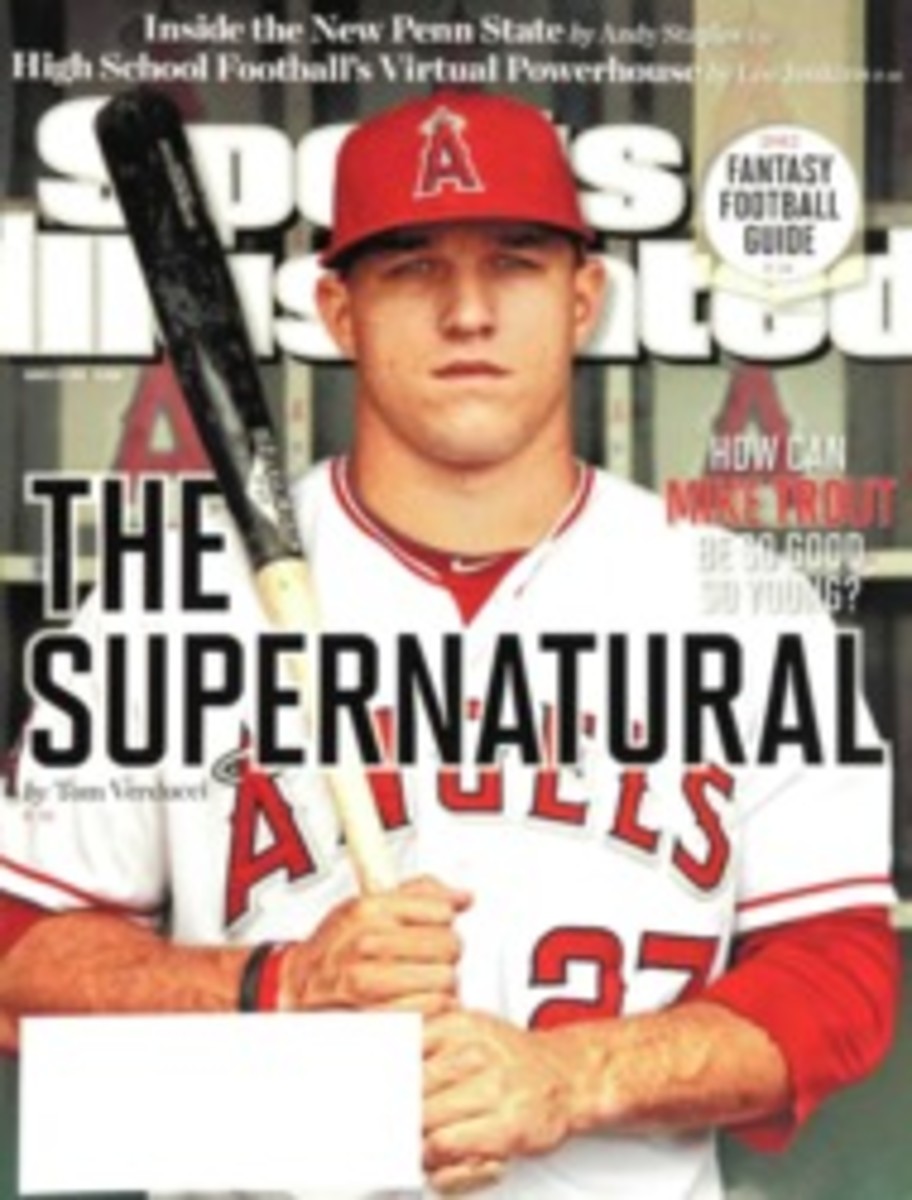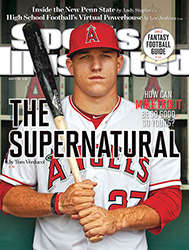
BLACK AND WHITE, AND GREEN ALL OVER
Ed Hochuli suffers from what he calls the sickness. In a typical year, around mid-May, the NFL heralds its upcoming season by mailing to game officials an arcane, hundred-question rules test, including such queries as: On an onside kick from the A35, A1 is the first to touch the kick at the A42, and A2 then recovers the kick at the A46. During the kick, B1 blocks A3 below the waist at the A44. What's the call and why?
But this year, well before the NFL Referees Association's collective bargaining agreement was set to expire on May 31, the zebras learned that no exam would be forthcoming. And so Hochuli, the NFLRA's famously mesomorphic elder statesman, preempted his union's impending—and now ongoing—lockout in the nerdiest way imaginable. For three months now, the 22-year veteran has been e-mailing his 120 fellow officials his own weekly test, replete with video clips.
What's more, on each of the past eight Mondays, always at 9:30 p.m. EDT, the 61-year-old has moderated a voluntary hour-long conference call in which participants dissect the test's thorniest questions. On Aug. 13, for example, 95 officials devoted 30 minutes to discussing the fouls that require a 10-second clock runoff.
"The sickness," says Hochuli, proudly, "is that some of us actually enjoy these things."
Which helps illuminate the larger nausea plaguing his cohort in the midst of the second-biggest labor dispute that the NFL has endured in as many seasons. At bottom is the locked-out officials' feeling of disrespect, wrapped up in pay (in 2011, the average salary for NFL officials was $149,000, lowest of the four major American sports) and pension issues, echoing the protests of the league's players amid their own lockout a year ago. As before, the terms of this debate are in public dispute. To review:
1. The NFL is proposing compensation increases of 5% to 11% per year over a proposed seven-year term for each official. The NFLRA, which sets its own pay scale but relies on the league to provide the aggregate pie to slice (last year it was $11.93 million), wants an aggregate increase of $2.2 million in 2012, and a $16.5 million boost over five years.
2. The NFL wants to transition officials, whom it deems part-time workers, from their "defined benefit" retirement plans to "defined contribution" 401(k) programs. The NFLRA wants to preserve the existing plan, shielding pensions from the stock market, but is willing to settle on grandfathering in current officials.
3. The NFL proposes hiring three additional crews (21 new officials) and introducing full-time referees, which it says will improve officiating. The NFLRA calls this an "attempt to divert attention" from the two previous issues. The union is not opposed to the notion of more crews and full-time officials, it says—if the two sides can agree on compensation.
Both sides met for federal mediation three times in July, followed by a short meeting earlier this month. As Scott Green, the NFLRA president and an official himself, sums it up, "We didn't make any progress." Asked for an educated guess on when this all might be resolved, another official speculated, "Two or three weeks into the season—but I have never seen our union so tight as they are now." (NFL execs said last week that they were prepared to open the season with replacements.)
In the meantime America's preferred on-field product is stalling. During the last referee lockout, which lasted two weeks in 2001, including the opening games of the regular season, replacements generally consisted of high-level college officials. Not the cream of the crop—those are the NFL-identified and formally scouted "finalists" who sit on a waiting list for league duty. But those '01 replacement refs at least could claim they were close.
This summer, however, on the mandate of the NCAA's officiating supervisors—of whom those from the five top conferences are all NFL officials—not a single current Football Bowl Subdivision official can be found among the 136 replacements signed and prepped by the NFL. Instead, the league staffed up by drawing from the high school ranks and lower divisions, including some officials who had retired or been dismissed. (At least the situation has offered one breakthrough: Line judge Shannon Eastin, of the Mid-Eastern Athletic Conference, became the first female NFL official to work a game.)
The NFL has asked coaches and players not to speak to the media about the replacement officials. In case they do, the league supplied talking points on the subject. Among them: "No, we don't agree that coaches and players will play fast and loose with the rules if the regular officials are not working."
Then, on Aug. 5, as if on cue, replacement referee Craig Ochoa, formerly of the Lingerie Football League, went out before the preseason-opening Hall of Fame Game between the Cardinals and the Saints and misidentified the winner of the coin flip.
A comedy of errors continued apace, ranging from an inexplicable holding penalty against Giants punt returner Jayron Hosley, to a touchback called after Bills special-teamer Ruvell Martin downed a punt at the four-yard line.
So bad was the first weekend of preseason that the NFLRA, which had circulated a list of 10 meaningful errors observed in the Aug. 9 Patriots-Saints tune-up, including a missed touchdown and an unflagged helmet-to-helmet hit, suddenly declined to do the same in Week 2. (Players get flagged for rubbing it in; refs, it seems, are above it.) Had they chimed in, they would have had plenty of material to work with. Before halftime of the Cowboys-Chargers warmup last Saturday, for instance, the replacements failed to return the ball to Dallas after a flagged helmet-to-helmet hit by San Diego safety Eric Weddle resulted in an interception by his teammate, Donald Butler. And this was after officials met for a lengthy pow-wow—a common sight lately—and subsequent booth replay.
Funny now, sure. In August. In the preseason. Even Patriots coach Bill Belichick mustered a chuckle when asked about the situation. Be certain, however: There will be no chuckling in September or, heaven forbid, January, if it gets that far.
One obvious explanation for so many missteps: NFL speed. "It's mind-blowing," says locked-out side judge Keith Parham, 44, a former Big East official who was a rookie last season. "And I officiated [Cardinals receiver] Larry Fitzgerald and [Jets cornerback] Darrelle Revis in college. Even linemen are moving at a fast pace. It's a blur."
That reality has sparked questions about how to prevent comedy (say, missed holds) from metastasizing into tragedy (head injuries). The NFL, through a spokesman, maintains that there is "more medical infrastructure in place than ever to protect players," pointing to the certified trainers watching from upstairs booths, the replacements' three months of training, and sidelines stacked with video monitors and officiating supervisors.
But it has struck the NFLPA and retired players alike as incongruous to rely on officials with no NFL experience, given commissioner Roger Goodell's strict safety regime, which included a memo last November calling on officials to serve as first responders by helping identify concussions.
Asked earlier this month by SI whether he was nervous about using replacements in the regular season, NFLPA executive director DeMaurice Smith stressed that safety was a prime worry. He graded his concern as a 12—on a scale of 1 to 10.
"If you want the game to be as safe as possible, you need the people who live the rules to police it," says former Giants wideout Amani Toomer, who played during the 2001 lockout. "Players are already figuring out what they can get away with. It's going to get very ugly."
In nonlockout years, the NFL's officiating ladder mirrors that of a classic apprenticeship. "You start at peewee," says Green, "then work junior high, jayvee, high school, small college, then D-I," usually over an average of 15 years. Once in the league, the dues-paying persists. A first-year official is virtually never given the head referee's white hat or assigned to a crew alongside another rookie. The burden of acclimating to the regular season is just too heavy.
"The difference in intensity from the preseason, when players are trying not to get hurt, to playing in a stadium full of 85,000 fans is astronomical," says Parham. "Those seven refs that are going to work Giants-Cowboys [in the Sept. 5 season opener] will be scared to death."
Not sold on the scariness? Consider the complexity of the pro rules and the seemingly infinite permutations that compel weekly conference calls to understand them. The official NFL rule book is 75,934 words long. The NFL case book, full of practice scenarios and rulings, is 77,260. The NFL instant-replay case book is 25,617. And the Penalty Enforcement Hopper book (hopper being ref-slang for play), the widely accepted manual that Hochuli wrote to help officials categorize infractions and determine their enforcements, is 11,519. Together, that's 190,330 words—almost 10,000 more than the New Testament. (The Bible doesn't even have diagrams.)
Invariably, during lunch at his day job—student accounts manager at Johns Hopkins's School of Advanced International Studies in Washington, D.C.—Parham finds himself heading to the library, NFL case book in tow. Hochuli, a partner at the Phoenix law firm of Jones, Skelton & Hochuli, still spends 10 hours per week, minimum, reviewing the rules.
Such workloads are typical. The NFLRA estimates that for 85% of its membership, officiating is their second job. That list includes Green, a partner at The Lafayette Group, a government contracting firm, who points out, "We've had guys lose their [non-NFL] jobs because of the time commitment."
Sunday-specific though the gig may appear, that commitment includes a post-game crew breakdown on Monday; the NFL's grading of each official's last game, which arrives on Tuesday; challenges for that grade on Wednesday; a test on Thursday—usually 25 multipart questions; travel and a pregame crew meeting on Saturday; and then the big, public exam on Sunday, followed by return travel.
Added up, it can be grueling. But at his desk in D.C., where a scrap of loose-leaf with a mnemonic device for under-two-minute rules hangs on the wall, Parham longs for those days. It's funny, he says: When he made his first NFL crew last year, his boss at Johns Hopkins gushed up and down the hallway. His Facebook account exploded with congratulations whenever he was spotted on television.
And now? Like Hochuli, he can't help but feel the sickness. Parham misses being tested, he admits. He even misses being booed.
Follow @SIPabloTorre
"THE DIFFERENCE FROM THE PRESEASON TO 85,000 FANS IS ASTRONOMICAL," SAYS PARHAM. "THOSE REFS WORKING THE OPENER WILL BE SCARED TO DEATH."
SI.COM
In Monday Morning Quarterback, Peter King weighs in on the latest in the referee situation at SI.com/NFL
PHOTO
Photograph by SEAN M. HAFFEY/ U-T SAN DIEGO/ZUMAPRESS.COM
WHAT'S THE CHARGE? Shannon Eastin, the first woman to officiate an NFL game, stood her ground going head-to-head with 6'6" Chargers tackle Jeromey Clary. She has avoided the glaring mistakes of other replacements.
PHOTO
MICHAEL J. LEBRECHT II/1DEUCE3 PHOTOGRAPHY (PARHAM)
UMPIN' AROUND As Parham (above), a locked-out second-year official, watches in limbo, stand-ins have come under heavy fire from the likes of New Orleans interim coach Joe Vitt (near left) and Tennessee's Mike Munchak (blue shirt).
PHOTO
MICHAEL DEMOCKER
[See caption above]
TWO PHOTOS
DAVID BERGMAN
[See caption above]
PHOTO
RICK BOWMER/AP
[See caption above]
PHOTO
ED SZCZEPANSKI/US PRESSWIRE
[See caption above]
PHOTO
MATTHEW EMMONS/US PRESSWIRE (FLAG)
[See caption above]
PHOTO
RIC TAPIA/ICON SMI

